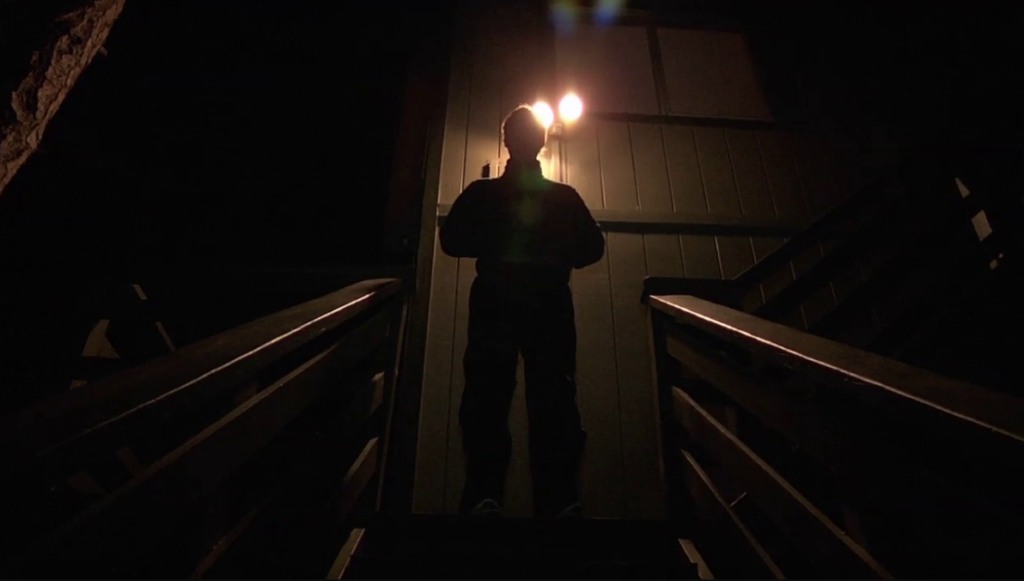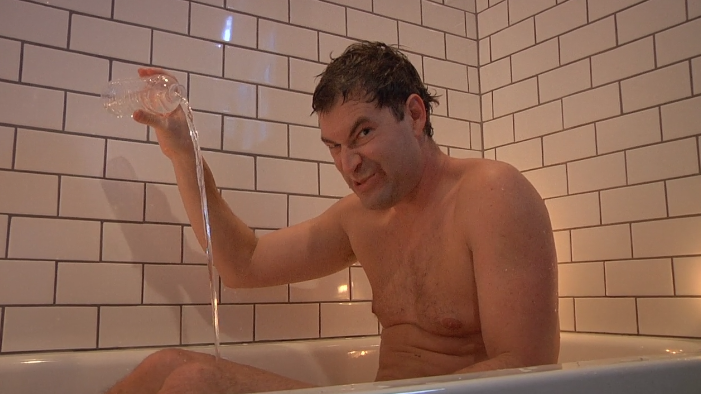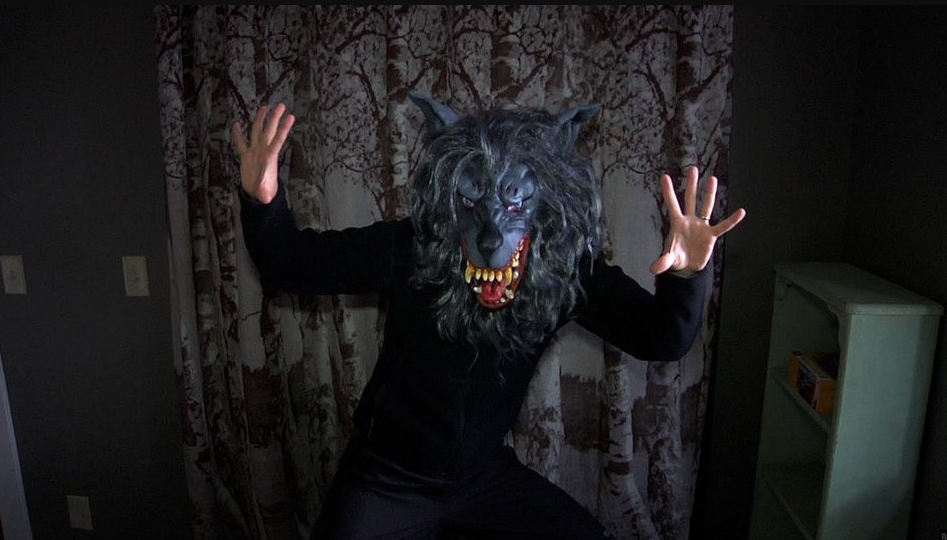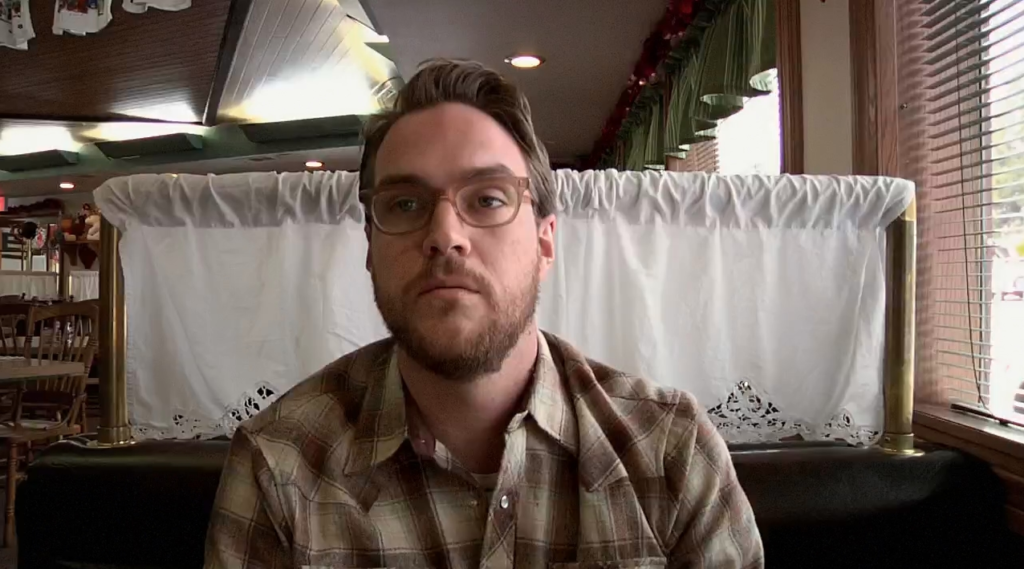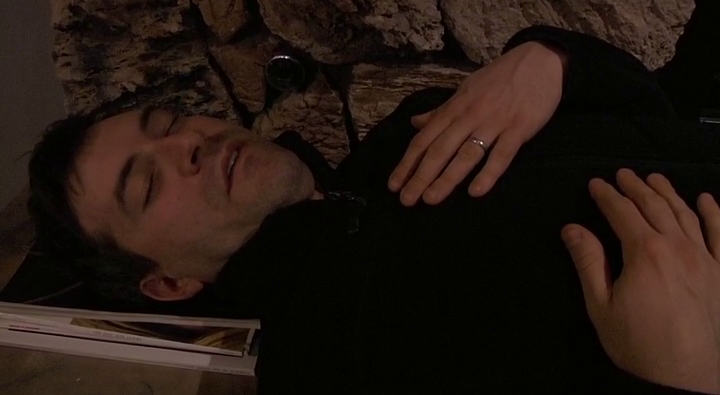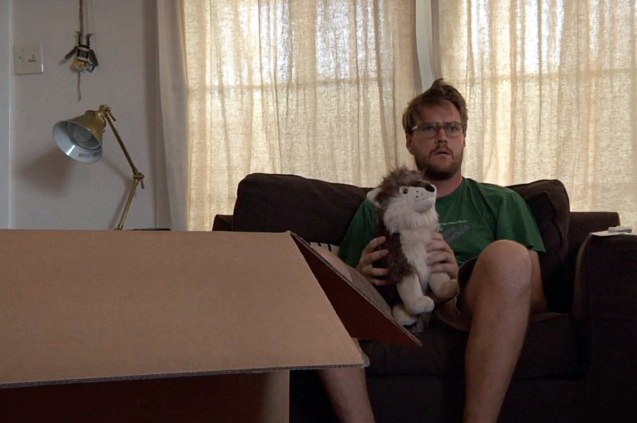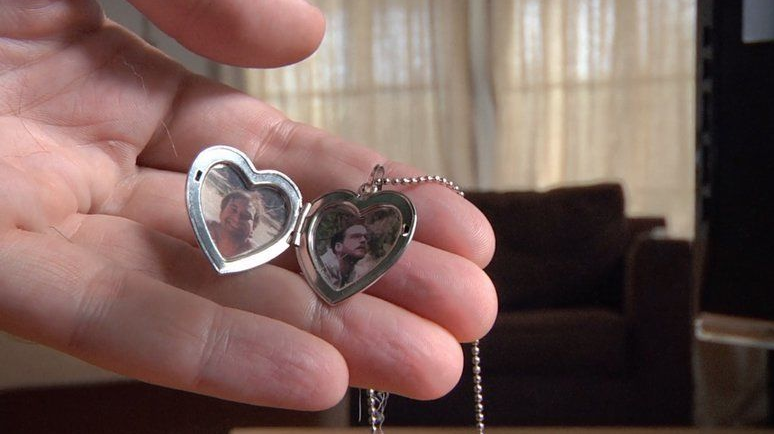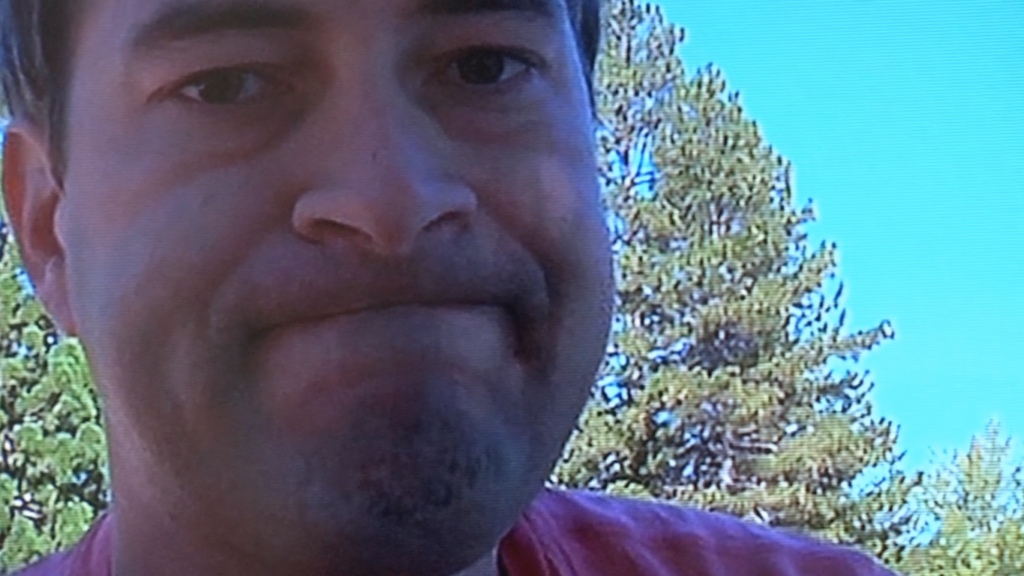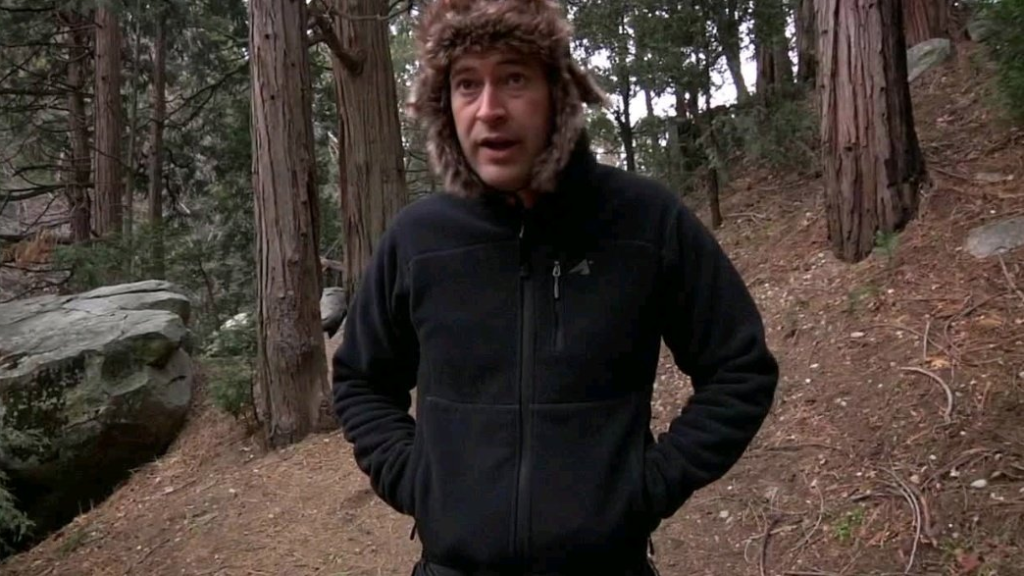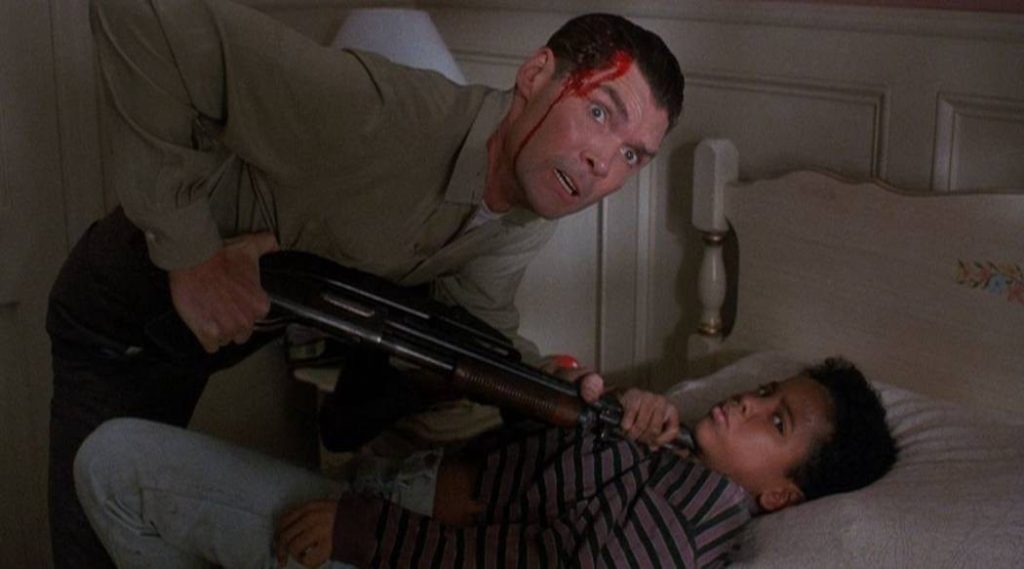
This January, in support of the Toronto Rape Crisis Centre / Multicultural Women Against Rape, friends and family have raised over $1,500 (which, when matched by my employer, totals $3,000). As a result, I now have to watch and write about thirty-one horror movies: one each night. Any donors who contributed over $30 were given the option to choose one of the horror movies I must subject myself to. After each viewing, I will write some things about said movies on this website. Be forewarned that all such write-ups will contain spoilers, and many of them will refer to unpleasant and potentially triggering situations. Today’s film is a second Wes Craven film (I usually try to avoid duplications, folks), The People Under the Stairs, chosen by friend, writer, editor, and communications consultant Richard Johnson. I picked up The People Under the Stairs from my local video store Queen Street Video.
What happens:
Trigger warnings: racism, child abuse.
The People Under the Stairs opens with a tarot reading. Ruby (Kelly Jo Minter) lays down cards for her brother Pointdexter (Brandon Quintin Adams) and pays special attention to the “Fool” card, because that’s what everyone calls him. She says the Fool has to walk through the sun to come out the other side a man. Pointdexter, or “Fool,” feels this reading has relevance to his current situation. After all, his mother, Mary (Conni Marie Brazelton) is very ill, Ruby is turning tricks out of desperation, and his family has just been evicted from their tenement housing. The landlords are pushing them out to set up a condominium. However, Ruby’s friend (maybe lover), Leroy (Ving Rhames), has an idea of how Fool might make some money and save his family from that eviction notice. (That’s a lot of pressure for a thirteen-year-old!)

So, what’s the scheme: Leroy and his white friend Spenser (Jeremy Roberts) robbed a liquor store and found an address: the same people who own the liquor store own Fool’s run-down apartment building, so Leroy now knows where they live. Ruby has heard some strange, scary stories about the landlords, but Leroy has heard they have a stash of gold coins. And he plans to make like a Black Mario, collect those coins until he gets a free life. We next see the family of landlords, and it seems the rumours Ruby heard were accurate. Mommy (an over-the-top Wendy Robie, doing a decent Mommie Dearest) watches the eating habits of her daughter, Alice (A.J. Langer), like a hawk to make sure she doesn’t feed “that thing in the wall.” Daddy (Everett McGill, also swinging for the fences) casually drops the N-word and beats his daughter with a belt like it’s 1910 Mississippi (rather than 1991 Los Angeles).
Leroy, Spenser, and Fool roll through the neighbourhood and study the landlords’ house: it’s large, but seems to be falling apart. Fool disguises himself as a Cub Scout to try to weasel his way inside, but Mommy doesn’t fall for his scam. Still, Fool is able to somewhat case the joint and determine the house’s doors and windows are locked from the outside-in. Spenser then attempts to get inside, dressed as a gas meter reader. Though Mommy is very hesitant to allow him inside, she eventually relents.
Waiting on the street in their black van, Leroy and Fool see the landlord and landlady leave in their black murder Cadillac, but Spenser still hasn’t returned. Leroy is convinced his partner is trying to screw him over and take all the coins for himself. He brings Fool with him as he breaks through a series of locked doors with a crowbar. Along the way, they see what looks like a large voodoo doll caught in a mousetrap. And once the final door opens, a massive Rottweiler attacks them. But thanks to Fool’s quick thinking, they trick the guard dog and manage to lock it outside.
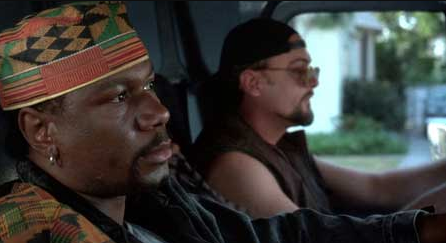
Leroy and Fool observe their surroundings: nearly every cabinet in the kitchen is locked, and dust and dead flies have piled up in every corner. “Nice to see rich folks get rats, too,” Leroy jokes. (Though we soon find out that rats are not the problem.) Leroy ventures upstairs to try to find Spenser but leaves Fool – who is visibly spooked by the dilapidated house – to stand guard on the main floor. However, Fool soon finds a secret basement entrance with hidden stairs. On those stairs lie Spenser’s fake gas-man clipboard and lighter. Against his better judgment, Fool remembers Leroy’s taunts and ventures into the terrifying cellar, pulling a trip wire that traps him inside.
Imprisoned in the dank basement, he searches for Spenser with the only illumination provided by a pocket lighter. He can hear people moving within the walls. He finds an old television tuned to CNN (and the night bombing of Baghdad during Desert Storm). Eventually, he finds the corpse of someone who looks like Spenser, but must be about 50 years older. In the body’s hand is a gold coin. (They do exist!) Fool tries to pull old Spenser’s body from the wall, but something (or someone) keeps dragging it back. Suddenly, a reedy man dressed like a Road Warrior extra leaps on Fool. Fool runs upstairs to escape, but with the flip of a switch, the stairs turn into a slide, and Fool skids back down into the basement. He recovers and runs up the ramp, but the door is still locked. Suddenly, it opens, and Fool is surprised to see a girl about his age (Alice) on the other side.
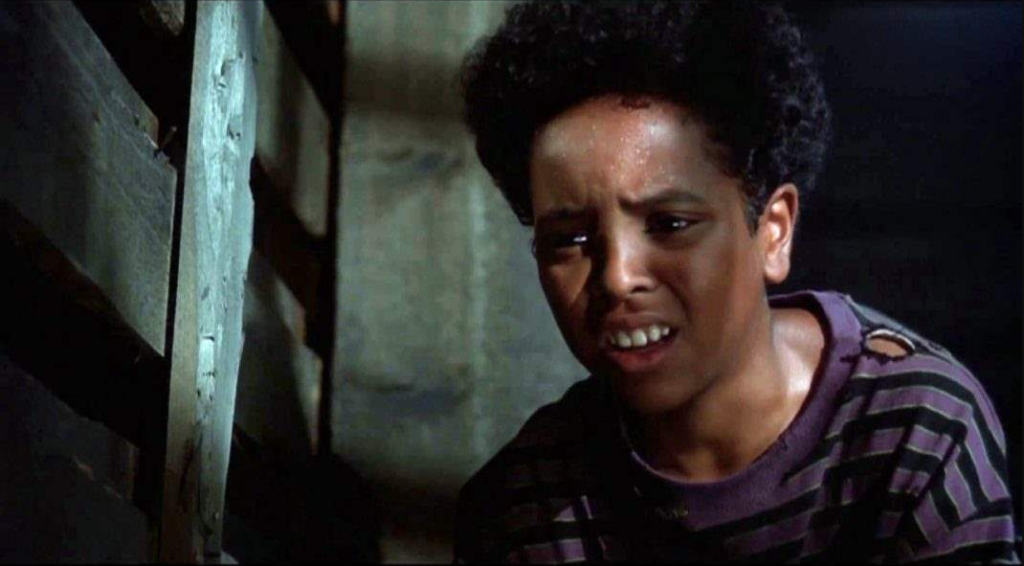
Fool is pulled back down by his ankle, but soon kicks himself free. When he escapes the basement, the girl is gone. But he sees through the front window that the landlords have returned from their afternoon drive. He runs upstairs to warn Leroy and finds him face-down on the floor. At first, he’s afraid Leroy is dead, but he’s on the floor for other reasons: he can heard something inside the walls. Fool tells him two important bits of information: (a) the creepy homeowners are back, and (b) Spenser is dead, seemingly frightened to death. “If you thought he was white before,” Fool grimly jokes, ”you should see that sucker now.”
Seeking a way out, Fool tries the front door, but discovers – the hard way – it’s electrified. Leroy tires to bash through the windows, but he has no luck either. Mommy and Daddy, seeing that someone has broken into the house in their absence and locked the dog outside, let Prince (the Rottweiler) have first crack at the intruders. The dog soon runs to the living room and locks onto Leroy’s wrist. So Fool leads the two of them to the front door, and using his and Leroy’s bodies as a conductor, electrocutes the dog. (Science?) They head upstairs to look for hiding spots as they hear Daddy load his pistol and the doors and windows lock shut.
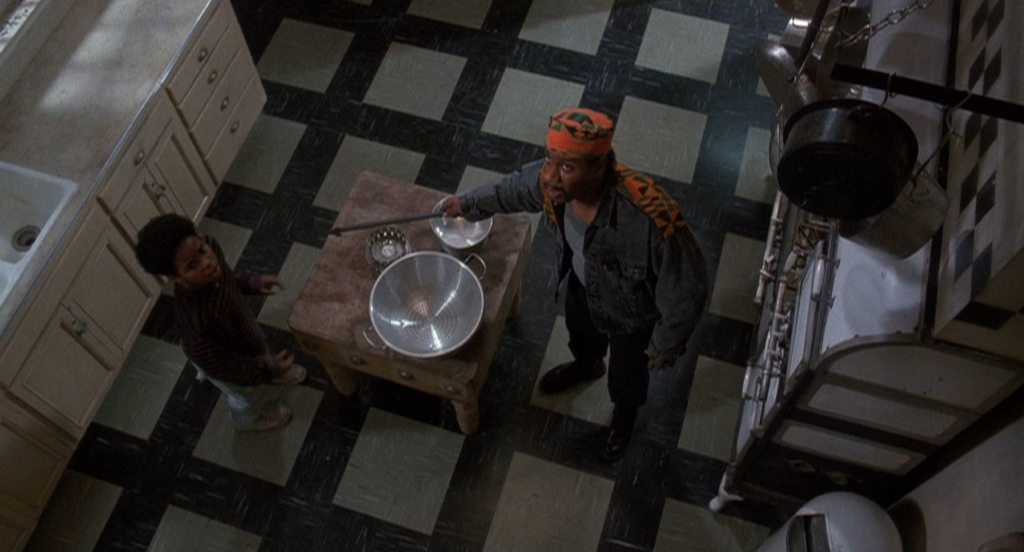
Leroy hides in a closet by himself but is soon terrorized by the teenager from the basement jumping out of the wall. Leroy stumbles out into the hallway and is shot to death by Daddy before tumbling down the stairs. With no other escape, Fool decides to go through a secret passage into the wall. Inside he finds a little shelter and bloody animal bones. Then, through a vent on the far side, he spots Alice. Daddy, in the hallway, fires his gun wildly at the walls while Fool escapes from the walls into the dilapidated bathroom where Alice is hiding.
After preliminary introductions, Fool learns that Alice has never been outside before: she is certain it’s not possible to leave the house. Fool asks her about the people who live under the stairs – within the walls of the basement. Alice says that her mom and dad have looked long and hard for the perfect boy child, but none of them worked out. So Daddy cut out the bad parts of the boys they kidnapped – anything that spoke, heard, or saw evil – and put them in the cellar. But they get fed and have access to flashlights, so they can’t be living all that bad. As for the person who looks like a post-apocalyptic Gomer Pyle, that’s Roach (Sean Whalen). Daddy hates Roach, because he escaped the cellar and lives inside the walls. We then see that Daddy has changed into full S&M; bondage gear. He fires a shotgun at will into the walls, aiming to kill Roach.
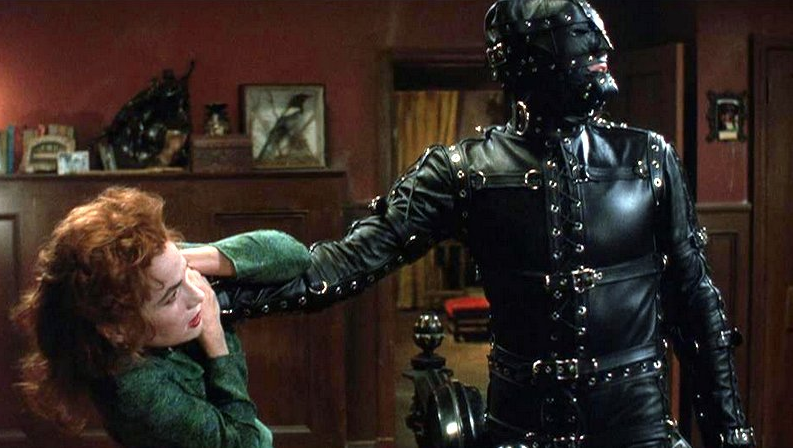
While Mommy feeds the recovered Prince Spenser’s severed hand, the 5-0 roll up into the driveway, having spotted a black van wanted in connection with a liquor store robbery. Daddy changes back to his street clothes, and he and Mommy answer the police officers’ questions in the driveway. They acknowledge that it appears someone is trying to break into their house, but they have it all under control. However, when the cops leave, Mommy notices something in the rear of the van: a discarded Cub Scout uniform. There’s still a boy inside the house with their “little angel.”
Alice and Fool separate, but angry dog Prince runs upstairs traps Fool in the bathroom. Daddy then tries to blow his way through the door with the shotgun. But when he does his best Jack Torrance, Fool smashes a tile on his head. Roach pops out and pulls the cornered Fool into the wall. Daddy tosses Prince into the wall to pursue them, but Roach uses a trap door to shake the dog. When Mommy and Daddy see Prince slide down a ramp toward them, they notice a doll in the dog’s mouth: the boy has already got to Alice!
Roach, Fool, and Alice reconvene in her bedroom. Fool learns why Roach is so quiet – Daddy cut out his tongue – and learns that Alice has a hobby of making dolls to hold the souls of salesmen and robbers that her parents have killed. She’s even made one of Leroy. (Fun! Also, she works very quickly.) That’s when Mommy and Daddy break into the bedroom and bust up the slumber party fun. Daddy captures Fool, Mommy slaps Alice around ,and Roach goes into hiding after being shot at a few times. Mommy announces that things are going to the next Defcon level: “TOTAL SPRING CLEANING.”
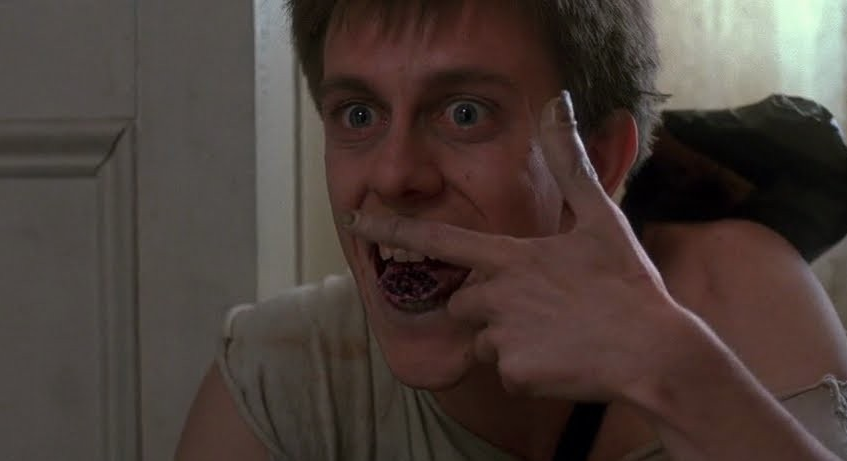
So what does “total spring cleaning” involve? Apparently it involves tossing Fool and Leroy’s dead body into the cellar, and forcing Alice to clean up all Leroy’s blood, like some sort of horror-themed Cinderella. Daddy accompanies the men to the basement, where he chops up Leroy’s body and tosses some of the meat to the mutants trapped in the wall. After Alice finishes cleaning the foyer, Mommy prepares a bathtub of scalding water and dumps Alice inside. Finished with feeding the people under the stairs, Daddy shoves Fool into the wall with them. The pale, vampiric boys – looking a bit like Morlocks from The Time Machine – threaten Fool, but Roach soon comes to the rescue by animating Leroy’s eviscerated corpse to scare the superstitious mutants away.
Roach hides himself and Fool in the dormant furnace (Wes Craven loves furnaces!), which is when Fool realizes his saviour has been shot. Some of Daddy’s buckshot got him in the side. Roach hands Fool some gold coins, then indicates how to reach Alice’s room, and dies. Fool scurries up to the secret entrance to Alice’s room, where Daddy is busy menacing his daughter. Fool punches the man in his groin, breaks a lamp over his head, and brings Alice with him back into the walls. Daddy run downstairs to light the furnace (and simultaneously burn Roach’s dead body) to help smoke the two kids out.
Alice and Fool journey through the walls, mindful of many booby traps set by Roach. Prince again bounds into the wall and attacks Fool. Daddy (in the hallway) hears the commotion and begins to bayonet the wall, hoping to hit the boy. But Fool turns the Rottweiler around and Daddy inadvertently stabs his own dog to death. But he doesn’t realize that’s what’s happened. When he sees the bayonet slick with blood, he assumes he’s murdered Fool and begins to do the dance of joy. It’s only when they pull open part of the wall and Prince staggers out dead that his glee evaporates.
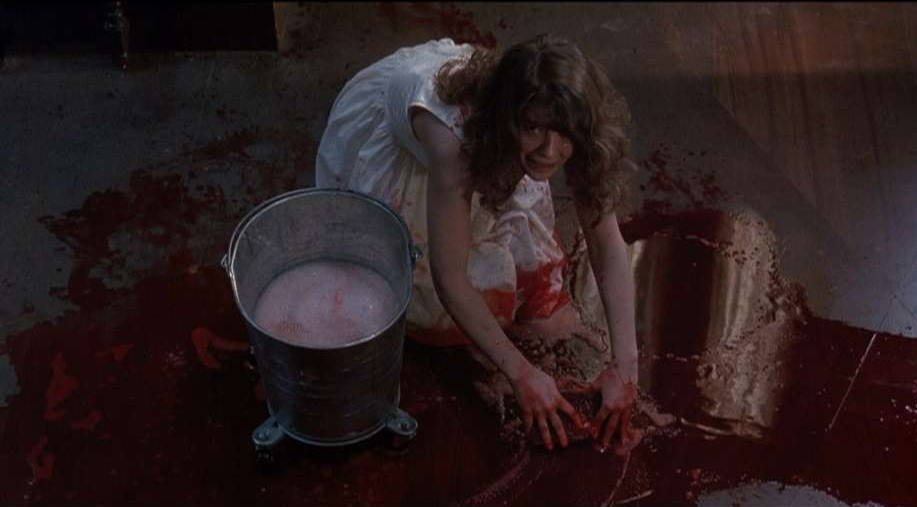
Fool guides Alice up to the house’s attic where the one openable window can be found. “I never thought smog would smell so good,” Fool remarks. Unfortunately, it’s a treacherous drop from the roof, and Alice is afraid to venture out the window. However, Daddy is on the way, so Fool takes his chances and slides down the roof, falling safely into the pond in their yard. Daddy runs downstairs and fires his gun into the bushes, but Mommy, mindful of the neighbours, warns him to never shoot his gun outside.
Fool returns to his grimy apartment. His grandfather, Booker (Bill Cobbs) appraises the coins and figures Fool’s family should be good for rent for the next ten years (and then some). Grandpa Booker (who we’ve never seen before) is a veritable Wikipedia of local superstition, noting that the landlords aren’t actually husband and wife – they’re brother and sister (!) – and that family has been twisted for centuries, each generation more depraved than the last. (Where was Grandpa Booker a day earlier?) Despite that, Fool feels the need to return to the house to rescue Alice. Ruby reads his cards again and advises against it, but Fool made a promise and he’s aiming to keep it.
An anonymous call to Child Welfare on the pay phone brings the police to the landlords’ creepy house. But by the time they arrive, Mommy and Daddy are making like Ozzie and Harriet, and the house has miraculously been cleaned up, weapons have been hidden (and walls repaired of multiple shotgun blasts, I guess). Most confusingly for the police summoned there, the couple appears to have no children at all. Satisfied the call was not legit, the police depart. But Fool uses the opportunity to hide in the cabinets. He drops out when Mommy and Daddy turn out the lights for the night.
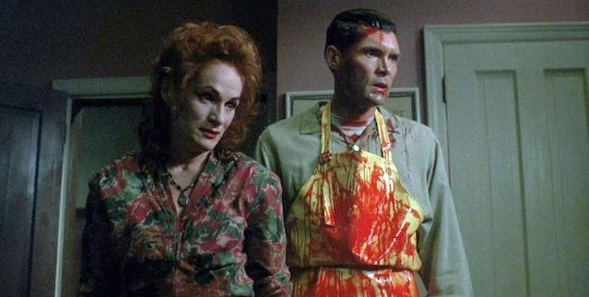
Fool arms himself with a fireplace poker and heads upstairs. He hears Mommy and Daddy saying their evening prayers, but when he reaches the source of their voices, he realizes he’s been tricked by a tape recording. Daddy – in mega-leatherdaddy mode – pops up behind Fool and seizes him. Fool gouges his eyes and attacks both adults with the fire poker, then runs into the walls. Alice, meanwhile, is hanging from the brick chimney in the attic by her arms, like she’s in a Mad Magazine cartoon. Though a series of secret passageways, Fool finds his way to the attic chimney and undoes the bolt that holds Alice. But Daddy re-enters the room, and Alice must pretend to still be manacled. The sight of Alice as prisoner gets Daddy randy (gross), and it’s only Mommy calling from downstairs that prevents something more heinous from happening.
Once Daddy leaves, Fool tells Alice that her parents aren’t her real parents. She must have been kidnapped by them as a child. They could escape via the roof again, but Daddy has already drained the pond and filled it with broken glass. In the master bedroom, Mommy and Daddy fight over Alice when they hear a stirring from within the chimney. Daddy takes a look up the flue and promptly has a brick dropped on his head. He doubles back in pain and Mommy decides to take a look for herself. Fool and Alice slide down (like Santa Claus) and crash onto the woman. They continue downward, with Fool heading to the basement to retrieve Daddy’s shotgun.
Alice has made her way to the living room, but is soon captured by Mommy who demands to know where Fool is. Alice stomps on her bare foot and tells her mother to “burn in hell.” When Mommy and Daddy meet up again, they decide that Alice has become expendable. Both of the kids loose in the house are to be killed on sight. Daddy finds Fool in the basement, and after some struggle, Daddy wrests the gun from him. He’s about to blow Fool’s head off when there’s a knock at the door. They hesitate, thinking it could be the police.
Instead of the authorities at the door, it’s the community. Ruby and Grandpa Booker have gathered the former residents of the slums that Mommy and Daddy own for a protest. Mommy first slams the door on them. While this is happening, the people under the stairs shine their flashlights in Daddy’s eyes, allowing Fool to escape. Ruby knocks on the door again. When Mommy answers, she prepares to shoot Ruby in the head, but Alice drops down from the ceiling and smacks Mommy’s skull against the floor. Daddy, in the basement, opens fire on the mutants in the wall and accidentally breaks open the lock that fences them in. They drag Fool into their pen once again. Daddy runs upstairs to escape the basement dwellers and is knocked down by Ruby and Grandpa Booker, entering the basement at the same time.
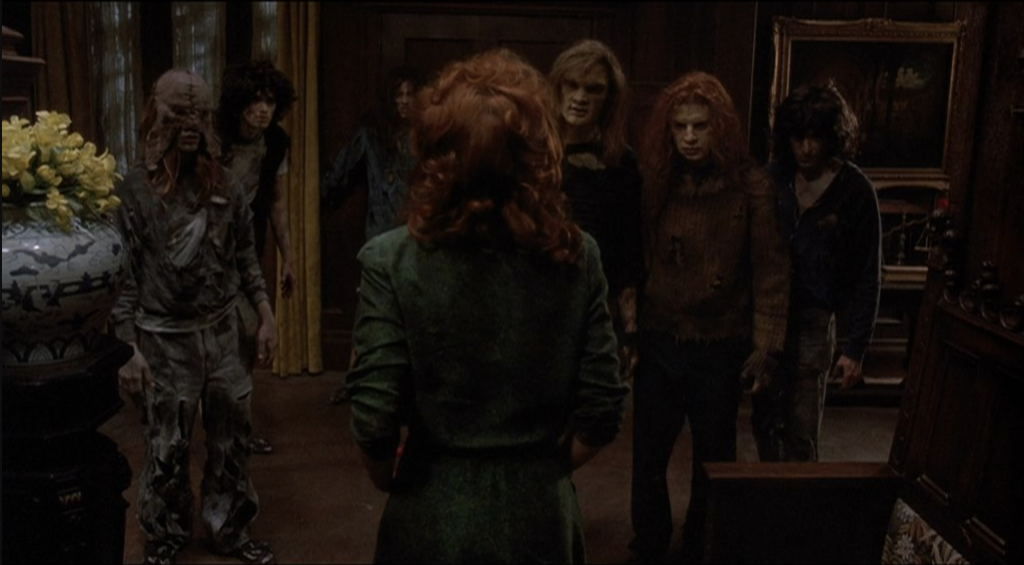
The people under the stairs guide Fool to a secret chamber, where he finds a stash of gold coins, paper bills, and riches worthy of Scrooge McDuck. “No wonder there’s no money in the ghetto,” he marvels. Upstairs, through some trickery, Mommy gets all the community members outside and locks all the doors once again. She chases after Alice with a butcher knife and pins her on the stairs. That’s when the mutants underneath tear through the floorboards and bite into her arm. Mommy recoils, but soon the basement mutants are breaking out of the walls and corners in every direction and attacking her. She runs to the kitchen where Alice stabs her in the stomach, then the basement captives swarm Mommy. They toss her dead body into the basement – her throat torn open – where Daddy finds her and weeps.
Fool finds something else in the vault of riches: dynamite. (What a weird place to keep it!) Daddy follows the boy into his vault and draws his shotgun on him. But Fool has the dynamite rigged to explode. It’s a tense standoff for a couple moments, but when Daddy twitches, Fool starts the explosion. The whole house goes off like a Roman candle and Daddy dies. (Fool, who was standing right beside him, remains unscathed: “I feel like a million dollars.”)
The crowd outside cheers as money blows out through the top of the roof and showers down upon them. A celebration of the oppressed tenants erupts in the streets and the cannibalistic basement dwellers secretly escape through the crowd and into the night. Ding dong, the witch is dead.
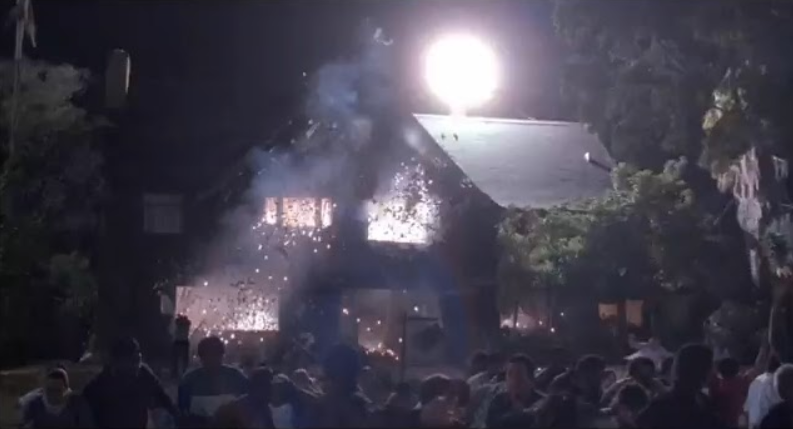
Takeaway points:
- The People Under the Stairs is easy to read as a broad, messy, satiric screed against the greed of (primarily white) urban landlords. Remember Donald Trump in the 1980s? Craven has essentially turned him into the perverted, murderous, leather-clad Daddy of this film. The greed of property owners kicks off the film, and it’s established that these white landlords have been hoarding the ghetto’s money under their own roof. Craven aims to expose the moneyed white class of Los Angeles as a thousand times more depraved and monstrous than any Black sex worker or thief. They’re also a class that the law serves to protect: both times the police arrive, they are more concerned with Black theft of property or so impressed by a veneer of white civility that they don’t uncover the evil under their very noses. And this class division is all the more relevant that it’s set in 1991 Los Angeles. One needs only to read about the 1984 Olympics or Operation Hammer (or the great chapter on Los Angeles in Kevin Smokler’s film book Brat Pack America) and how it helped widen the already growing rift between white and Black, rich and poor in Los Angeles in the 1980s (and today) to see why.
- Though there’s a lot about race and class warfare in America (and Los Angeles, in particular) within The People Under the Stairs, it almost seems best to treat the film as a Wes Craven fairy tale. The trappings are there: a mysterious house, wicked step-parents (of a sort), a girl named “Alice.” The film follows the folkloric journey of our pauper hero (Fool) into the evil witches’ gingerbread house where children go to die, but transports those themes and tropes to a modern, urban setting.
- The film is allegedly based on true events. Craven wrote the story after reading a news article about burglars breaking into a house. When the authorities responded to the call, the burglars were nowhere to be found. Police instead found a terrible case of child abuse: the home owners who called for the police had kept their children locked inside their rooms for years. Does that make The People Under the Stairs scarier? Probably.
- The actors playing Mommy and Daddy (Wendy Robie and Everett McGill) have been a couple before, though a much more pleasant one: Craven got the idea of casting them as the incestuous brother-sister after watching them work their magic on Twin Peaks as a married couple who don’t really love one another, Nadine and Big Ed.
- Wiser people than me have noted that The People Under the Stairs is a total inversion of Home Alone, which premiered only the year prior – right down to the booby traps. In Home Alone we root for the affluent white kid as he tortures thieves in new and unusual ways. In Craven’s film, our loyalties lie entirely with the thieves. That’s because in reality, the rich homeowner isn’t an adorable moppet like Macaulay Culkin; he’s a racist, avaricious monster like Mommy and Daddy.
Truly terrifying or truly terrible?: Not terrifying, not terrible – just a weird ride that maybe shouts its themes a bit too loudly.
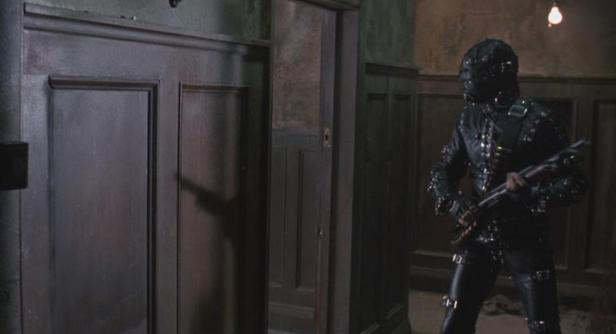
Best outfit: Daddy’s full-body Leatherdaddy hunting outfit makes a strong statement about traditional Christian values.
Best line: “I know it’s a bother, but so is cerebral palsy.” – Fool, with an incredible charity sales pitch.
Best kill: There’s definitely something enjoyably reminiscent of the finale of Tod Browning’s Freaks in the way that Mommy dies at the hands of the many hideous basement captives.
Unexpected cameo: The actress who portrays Fool’s ailing mother, Conni Marie Brazleton, is known to millions as Nurse Connie Oligario in nearly ten seasons of medical drama, ER. And you probably know A.J. Langer (Alice) as Rayanne Graff.
Unexpected lesson learned: Before you do anything, make sure you consult with Grandpa Booker.
Most suitable band name derived from the movie: The People Under the Stairs are a successful hip-hop group that took their name from this film. But if I had to pick another band name, it would be Total Spring Cleaning.
Next up: Basket Case (1981).
